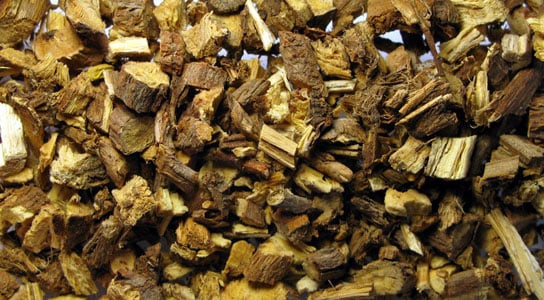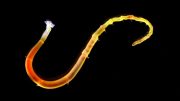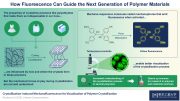
Unexpectedly sweet help in the battle against diabetes: scientists have identified a group of natural substances with an anti-diabetic effect, the amorfrutins, in the edible roots of the liquorice plant Glycyrrhiza. Credit: Alexander Vögtli, PharmaWiki
It not only serves as a tasty raw material for candy, it has medicinal purposes as well. Scientists have found that the liquorice root contains a group of natural substances with an anti-diabetic effect, the amorfrutins, in the plant’s edible root. Research on diabetic mice confirmed that amorfrutins are not only anti-inflammatory, but they also have characteristics that reduce blood sugar and prevent fatty liver.
It provides the raw material for liquorice candy, calms the stomach and alleviates diseases of the airways: liquorice root. Chosen as the “Medicinal plant 2012”, the root has been treasured in traditional healing since ancient times. Researchers at the Max Planck Institute for Molecular Genetics in Berlin have now discovered that liquorice root also contains substances with an anti-diabetic effect. These amorfrutins not only reduce blood sugar, they are also anti-inflammatory and are very well tolerated. Thus, they may be suitable for use in the treatment of complex metabolic disorders.
Natural substances have a surprising and often largely unexploited potential in the prevention and treatment of common diseases. For example, liquorice root Glycyrrhiza contains different substances that help to alleviate disorders of the airways and digestive system. It has been used for millennia in traditional healing and is mainly administered in the form of tea. A team of researchers working with Sascha Sauer from the Max Planck Institute for Molecular Genetics in Berlin has now discovered that the plant from the papilionaceae or leguminous family might also be effective in the treatment of adult (type 2) diabetes. The scientists identified a group of natural substances with an anti-diabetic effect, the amorfrutins, in the plant’s edible root.
The substances, which have a simple chemical structure, are not only found in liquorice root, but are also in the fruit of the Amorpha fruticosa bush. The new anti-diabetic agents were named after this plant, which is native to the US, Canada and Mexico. As the researchers demonstrated using diabetic mice, the amorfrutins not only have characteristics that reduce blood sugar, they are also anti-inflammatory in their effect. Moreover, they also prevent fatty liver – a common disease caused by excessively fat-rich nutrition.
“The health-beneficial effects are based on the fact that the amorfrutin molecules dock directly onto a receptor in the nucleus called PPARγ,” explains Sascha Sauer. PPARγ plays an important role in the cell’s fat and glucose metabolism. The binding of the amorfrutin molecules activates various genes that reduce the plasma concentration of certain fatty acids and glucose. The reduced glucose level prevents the development of insulin resistance – the main cause of adult diabetes.
“Although there are already drugs on the market that affect the PPARγ receptor, they are not selective enough in their effect and cause side effects like weight gain and cardio-vascular problems,” says Sascha Sauer. In contrast, as demonstrated by the studies carried out to date, the amorfrutins are very well tolerated. “However, drinking liquorice tea or eating liquorice will not help to treat diabetes,” explains the scientist. “The concentration of the substances in the tea and liquorice is far too low to be effective.” The researchers therefore developed special extraction processes to obtain the amorfrutins from the plant in sufficient concentrations. This could be used to produce amorfrutin extracts on an industrial scale.
The newly discovered active substances not only seem to hold great promise for the treatment of complex metabolic disorders, they may also be suitable for prophylactic use. “The amorfrutins can be used as functional nutritional supplements or as mild remedies that are individually tailored to the patient,” says Sascha Sauer. “In view of the rapid spread of metabolic diseases like diabetes, it is intended to develop these substances further so that they can be used on humans in the future.” To do this, the researchers must now test the effect of the substances and the plant amorfrutin extracts in clinical studies on diabetes patients.
Reference: “Amorfrutins are potent antidiabetic dietary natural products” by Christopher Weidner, Jens C. de Groot, Aman Prasad, Anja Freiwald, Claudia Quedenau, Magdalena Kliem, Annabell Witzke, Vitam Kodelja, Chung-Ting Han, Sascha Giegold, Matthias Baumann, Bert Klebl, Karsten Siems, Lutz Müller-Kuhrt, Annette Schürmann, Rita Schüler, Andreas F. H. Pfeiffer, Frank C. Schroeder, Konrad Büssow and Sascha Sauer, 16 April 2012, Proceedings of the National Academy of Sciences.
DOI: 10.1073/pnas.1116971109









In my coutry there are stores that only sell liquorice. Hundreds of varieties. But if you go to the neighboring countries like Belgium or Germany, nobody likes it.